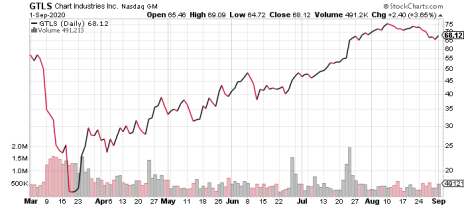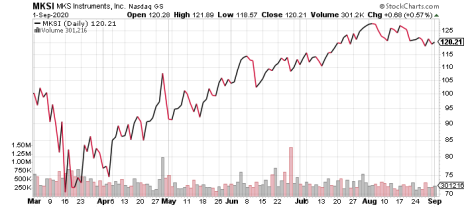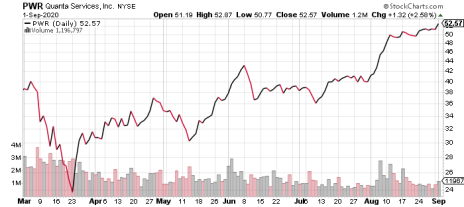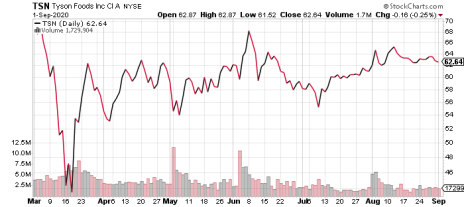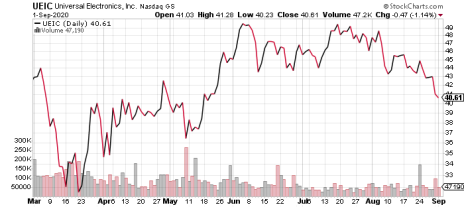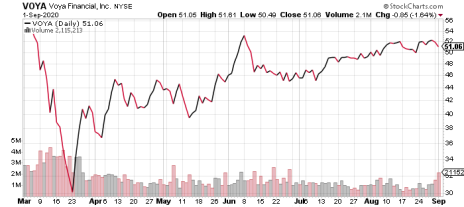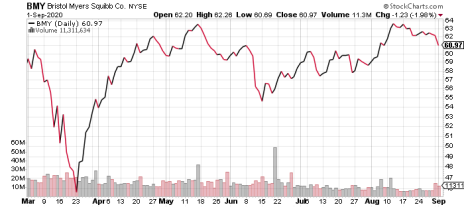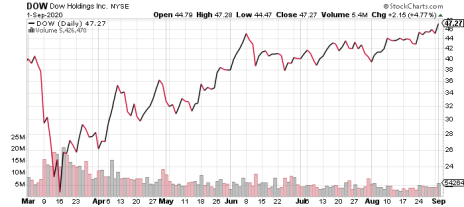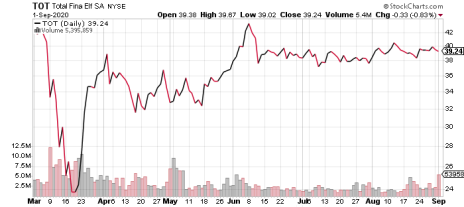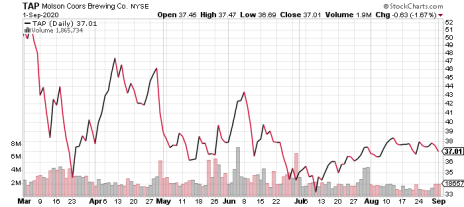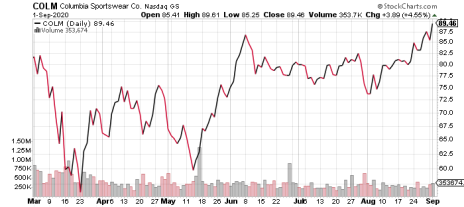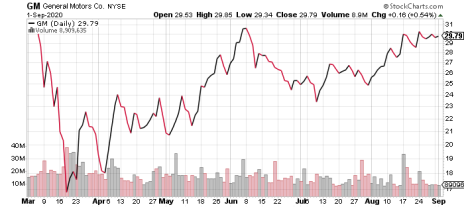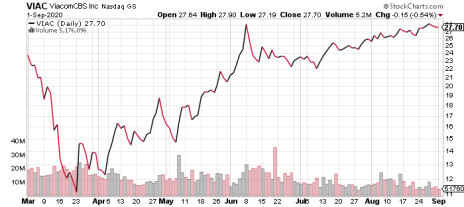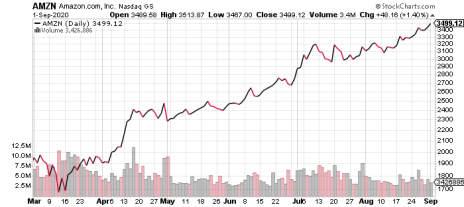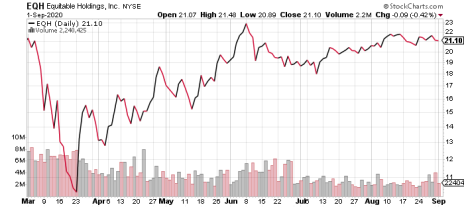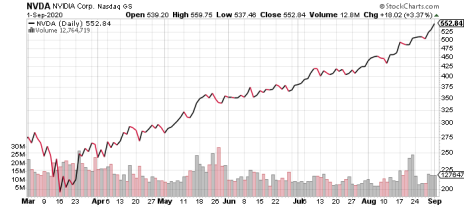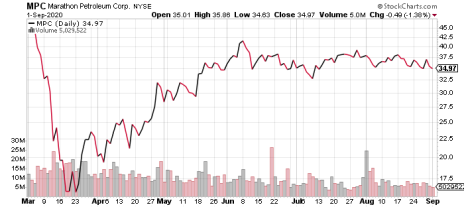Thank you for subscribing to the Cabot Undervalued Stocks Advisor. We hope you enjoy reading the September 2020 issue.
With earnings season mostly completed, the markets have drifted upwards in the waning days of this otherwise unusual summer. Some splashy IPOs and stock splits have provided some excitement, but the bigger and more enduring news came from the Fed’s official change in its priorities. We discuss our thoughts on this shift in the letter.
We also introduce price targets for several recommended stocks. Over the next few weeks, we will provide targets for the remaining stocks and all newly recommended stocks. Price targets help stay the course when our stocks weaken on noise, and provide a tangible exit point. The assumptions behind the price targets provide a roadmap to gauge the company’s recovery process.
Please feel free to send me your questions and comments. This newsletter is written for you and the best way to get more out of the letter is to let me know what you are looking for.
I’m best reachable at Bruce@CabotWealth.com. I’ll do my best to respond as quickly as possible.
Cabot Undervalued Stocks Advisor 920
[premium_html_toc post_id="213566"]
Don’t Fight the Fed?
The U.S. Federal Reserve Bank, called by its colloquial name “the Fed” even on its website, made its informal but landmark policy change official last week. For the foreseeable future, the Fed will keep interest rates near zero, focusing almost exclusively on employment.
With its immense financial arsenal, the Fed, as our central bank, has the ability to exert market-bending pressure. The simple yet proven maxim “don’t fight the Fed” has provided a useful guide to investors. This maxim applies to local markets around the world. The highly successful investor Jim Rogers, in his book Investment Biker, a fascinating story about his circle-the-world motorcycle ride to find new ideas, echoed this when he said the first question he asked before investing in a country was, “What is the central bank doing?”
Founded in 1913, the Fed has served as a lender of last resort to help stave off financial panics, which had occurred somewhat frequently. In 1893 and 1907, for example, J.P. Morgan himself stepped in to rescue collapsing markets.
In its 107-year history, the Fed’s priorities have evolved to reflect changes in the economy. Prior to World War II, its role generally remained limited to maintaining financial market stability and preserving the value of the dollar. With the arrival of the war, the Fed’s policy shifted to helping keep interest rates low to facilitate the government’s war borrowings. In the decades after the war, the Fed’s primary objective was to keep inflation tamped down – occasionally raising interest rates to “remove the punch bowl just as the party was getting started.” Not fighting the Fed proved to be a healthy investment strategy.
As global growth rates slowed, the Fed’s policy migrated toward helping bolster domestic employment. In 1977, Congress made this official when it established the often-mentioned dual mandate to promote “maximize employment (and) stable prices.” The Fed’s market-crushing but extremely successful campaign to lasso inflation in the late 1970s helped usher in decades of rising employment.
The 2020 pandemic, however, has weighed heavily on already-weak secular U.S. and global growth. We’ll write more about our apparently unique view on why secular growth has flattened in future letters. For investors, not “fighting the Fed” again has proven to be a useful strategy. The Fed’s extremely aggressive efforts in March to support capital markets (combined with gargantuan government stimulus packages) triggered the stunning rally in nearly all asset prices.
The key message is that the Fed cares little about inflation anymore, and instead is almost exclusively focused on maximizing employment. Interest rates will be kept near zero for the indefinite future. Not fighting the Fed suggests a continued surge in stock prices.
But, as it seemingly always does, the “not fighting the Fed” strategy will eventually overextend itself and then unravel. No one knows when that point will arrive. Easy money in the late 1960s led to the grinding 1970s bear market. Excessive liquidity in the late 1990s spawned the collapse of tech stocks starting in 2000, just as easy money (then rising interest rates in 2005-2007) sparked the market’s collapse in 2008-09. Today, essentially free money has lifted share prices to new records but has also sowed the seeds for the next bear market.
We think the Fed will remain focused on employment until other problems catch its attention. The weakening dollar, early signs of inflation, political pressure to further expand its mandate – any one of these or a myriad of other issues could once again destabilize the currently momentum-driven markets, or at a minimum produce a change in which sectors the market favors. Focusing on stocks that are already out of favor should help investors preserve and build their portfolios.
Price Targets
With this issue, we are setting price targets for many of our stocks. In subsequent issues, we will provide targets for the remaining stocks as well as for each newly recommended stock. Price targets help us stay the course when our stocks weaken on noise, and help provide a tangible exit point. The assumptions behind the price targets provide a roadmap to gauge the company’s recovery process.
Please send me your comments and questions – I’ll work to respond as quickly and helpfully as I can.
Upcoming Earnings Releases
September 3: Broadcom (AVGO)
Today’s Portfolio Changes
Molson Coors Beverage Company (TAP) – Moves from Buy to Strong Buy
Voya (VOYA) – Moves from Strong Buy to Buy
Portfolio Changes During the Past Month
Amazon.com (AMZN) – Moves from Hold to Retired
Universal Electronics (UEIC) – Moves from Strong Buy to Buy
ViacomCBS (VIAC) – New Buy
NVIDIA (NVDA) – Moves from Hold to Retired
Share prices in the table reflect Tuesday (September 1) closing prices. Please send your questions and comments to Bruce@CabotWealth.com.
Growth Portfolio
Growth Portfolio stocks have bullish charts, strong projected earnings growth, little or no dividends, low-to-moderate P/Es (price/earnings ratios) and low-to-moderate debt levels.
| Stock (Symbol) | Date Added | Price Added | Price 9/1/20 | Capital Gain/Loss | Current Dividend Yield | Rating |
| Chart Industries (GTLS) | 07-14-20 | 51 | 68 | 33.0% | — | Buy |
| MKS Instruments (MKSI) | 02-19-20 | 117 | 120 | 3.1% | 0.7% | Hold |
| Quanta Services (PWR) | 12-03-19 | 41 | 53 | 29.5% | 0.4% | Buy |
| Tyson Foods (TSN) | 12-10-19 | 89 | 63 | -29.7% | 2.7% | Buy |
| Universal Electronics (UEIC) | 11-04-16 | 57 | 41 | -29.0% | — | Buy |
| Voya Financial (VOYA) | 05-31-18 | 52 | 51 | -2.0% | 1.2% | Buy |
Chart Industries (GTLS) is a leading global manufacturer of highly-engineered equipment used in the production, transportation, storage and end-use of liquid gases (primarily atmospheric, natural gas, industrial and life sciences gases). Its equipment cools these gases, often to cryogenic temperatures that approach absolute zero. Chart has no direct peers, offering turnkey solutions with a much broader set of products than other industry participants. The company was featured in “Cabot’s 10 Best Stocks to Buy and Hold for 2020.”
The company generates positive free cash flow and is prioritizing reducing its modestly elevated debt from its 2019 cash acquisition of Harsco’s Industrial Air-X-Changers business, as well as continuing its sizeable cost-savings program.
While second-quarter sales growth was flat and adjusted per-share earnings fell about 7% from a year ago, the company reinstated its earnings guidance for full-year 2020 that was above estimates. Chart provided encouraging updates on its cost savings programs and described new initiatives and orders in hydrogen-based energy equipment.
While it is unclear what the chances are for rapid growth in hydrogen applications, the recent thrall over the potential for hydrogen-based vehicle fuels has probably helped push up GTLS shares following its earnings call. Some of that enthusiasm has faded.
On August 25, the company reached an agreement to sell its non-core MVE Biological Products (Cryobiological) business for $320 million in cash. This business produces cryogenic equipment for biopharma and related uses. Proceeds will be used to reduce Chart’s debt and possibly for future acquisitions in core product areas. We are a tad disappointed in the price – particularly as the buyer’s shares (Cryoport - CYRX) surged over 60% on the news.
GTLS shares jumped 4% yesterday, offsetting some recent weakness which partly reflected the disappointing deal price. However, if Chart can better capture new and more related revenue opportunities through internal efforts or through acquisitions, and can make progress in its hydrogen efforts, this minor issue will be long forgotten.
We are setting a 79 price target on Chart shares, about 16% above the current price, or about 54% above the 51 price at our initial recommendation. This is based on an enterprise value/earnings before interest, taxes, depreciation and amortization (or, EV/EBITDA, with EBITDA being a measure of cash operating earnings) of about 12x on estimated 2022 results. This translates into about 19.5x estimated 2022 per-share earnings of $4.06.
The current valuation remains reasonable at 21.5x estimated 2021 earnings of $3.17 and 16.7x estimated 2022 earnings of $4.06. Estimates have declined largely due to the pending Cryobiological unit sale. The shares look poised to continue their recovery. BUY
MKS Instruments (MKSI) generates about 49% of its revenues from producing critical components that become part of equipment used to make semiconductors. MKS’ products are generally in the stronger segments of this currently healthy market. While MKSI shares closely track the broad semiconductor indices, the expansion of its Advanced Markets segment, including its 2016 acquisition of Newport Corporation, as well as its 2019 acquisition of semiconductor-related Electro Scientific Industries, may allow its shares to break out. The company recently promoted 13-year company veteran Dr. John T.C. Lee to CEO.
MKS reported strong second quarter results, with revenues increasing 15% from the prior year. The company continues to benefit from strong demand for semiconductor equipment. Adjusted earnings per share of $1.62 were 49% higher than a year ago and about 37% above consensus estimates. Operating and free cash flow, which hit record levels, are helping the company whittle down its debt. Its debt balance, net of cash, was $223 million, down from $360 million at year-end. Management said that new export rules from the Department of Commerce won’t have a significant impact on the company’s financial results. The ESI acquisition added incrementally but its full potential has yet to be realized.
The company raised its 3Q guidance substantially: new guidance is for revenues of $560 million (midpoint of range) and adjusted earnings per share of $1.75 (midpoint).
MKSI shares have pulled back about 2% in the past week, while the Philadelphia Semiconductor Index (SOX) has continued to tick upward.
For traders with sizeable profits, it might be time to trim out. For longer-term holders of MKSI, at 15.3x estimated 2021 earnings of $7.84, we consider the shares reasonably undervalued. HOLD
Quanta Services (PWR) is a leading specialty infrastructure solutions provider serving the utility, energy and communication industries. Their infrastructure projects have meaningful exposure to highly predictable, largely non-discretionary spending across multiple end markets, with 65% of revenues coming from regulated electric, gas and other utility companies. Quanta achieved record annual revenues, operating income and backlog in 2019, and is pursuing a multi-year goal of increasing margins. Dividend payouts and share repurchase activity have continued uninterrupted during the pandemic.
We view this company as high quality, well run and resilient. The market views PWR shares as a safe haven in an unpredictable market and economy, helping the shares to fully recover from their March 2020 lows. The new 15-year contract to operate and modernize Puerto Rico’s energy grid is an encouraging positive as the company is seeking to shift toward a capital-light, recurring profit model. Quanta Services was featured in the July monthly issue of Cabot Undervalued Stocks Advisor.
Quanta reported strong second-quarter results, with per-share earnings of $0.74 more than doubling its year-ago results. Earnings were 57% above the consensus estimate. From a quality perspective, Quanta removes a lot of costs from their reported earnings to arrive at adjusted earnings – it’s not uncommon to see their adjusted results be 50% higher than reported results. One not-acceptable adjustment: stock-based compensation, or stock options. Few companies make this adjustment anymore. And, for Quanta, it boosted adjusted earnings above GAAP profits by 30% – much too large to ignore.
Overall, the company is executing its growth strategy relatively well. The company raised its full-year 2020 earnings guidance by 4% and announced a $100 million share buyback program. The shares are trading essentially at their record highs.
We are putting a 61 price target on Quanta shares, about 16% above the current price and about 55% above the 39.23 price when we assumed coverage. The target is based on 8x EV/EBITDA using 2021 estimated results. This translates into about 15.2x estimated 2021 earnings.
PWR shares currently trade at 15.9x estimated 2020 earnings of $3.30 and about 13.1x estimated 2021 earnings of $4.02. For long-term holders, Quanta stock looks well-positioned to continue to prosper, but investors may want to wait for a pullback after the surge in price to establish new positions. BUY
Tyson Foods (TSN) is one of the world’s largest food companies, with over $42 billion in revenues last year. Beef products generate about 36% of total revenues, while chicken (31%), pork (10%), and prepared/other contribute the remaining revenues. It has the #1 domestic position in beef and chicken with roughly 21% market share in each. Its well-known brands include Tyson, Jimmy Dean, Hillshire Farms, Ball Park, Wright and Aidells. As only 13% of its sales come from outside the United States, Tyson’s long-term growth strategy is to participate in the growing global demand for protein.
Tyson reported strong second-quarter earnings, supported by rising beef and pork prices, and absorbed a sizeable $340 million of direct Covid-related costs. The company is producing strong cash flow, and its balance sheet and liquidity remain healthy. New CEO Dean Banks (joined Tyson in 2017) brings fresh ideas and valuable technology and leadership experience gained at Google and elsewhere, although his very limited consumer products experience presents a bit of a risk.
TSN shares have traded down modestly in the past week. The company has more work to do to convince investors that the future is brighter, particularly as more of a commodity company (and hence lower margins) compared to its food processor peers, but this quarter’s results should help. As more restaurants re-open, Tyson should see improvements in its results.
We are setting a 75 price target on Tyson shares, about 19% above the current price. The target is based on 7.5x EV/EBITDA on estimated FY2022 results. This price translates into about 10.7x estimated per-share earnings of $7.00.
Tyson currently trades at 12.6x estimated 2020 earnings of $4.99/share and 10.7x estimated 2021 earnings of $5.87, and offers a 2.7% dividend yield. BUY
Universal Electronics (UEIC) is a major producer of universal remote controls that subscription broadcasters (cable and satellite), TV/set top box/audio manufacturers and others provide to their customers. The company pioneered the universal remote, named the ‘One for All’, which was quickly adopted by consumers after its launch in 1986. Since then, the company has expanded into a range of remote control devices for smart homes, safety and security and other residential and commercial applications, driven by its proprietary technology. The company has a global roster of customers, with about 40% of sales produced outside the United States. Comcast is a 10%+ customer and they hold warrants for up to 5% of Universal’s shares.
Strong and steady revenue and earnings growth drove the shares to over 80 by mid-2016, from only about 12 in mid-2012. However, the shares have stumbled sharply from their peak. Falling numbers of cable TV subscribers have pressured the company’s P/E multiple despite revenues and profits that keep (slowly) increasing.
The company reported second-quarter adjusted earnings of $0.89/share that were about 5% ahead of the $0.85 consensus estimate. While adjusted earnings per share reached a record $1.70 in the first six months of the year, revenues continue to weaken. Revenues were hurt by falling numbers of new cable subscribers, which the company attributes to the difficulties that cable installation technicians had in entering homes during the Covid pandemic.
Earnings have continued to grow because the company has expanded its gross margins, partly by selling more higher-margin QuickSet-enabled devices (proprietary technology that allows installation without technician visits) and partly by turning away lower-profit revenues (so, another source of revenue pressure, but a good one). The stronger dollar has reduced its import costs from China, where much of its products are made. Also, the company is generating more royalty revenues, which essentially are 100% gross margin revenues. Universal is also cutting its overhead costs while reinvesting more in research and development – both are the right moves. Operating margins reached 9.5% in the quarter and the company guided 3Q operating margins to 10%.
For UEIC shares to start a sustained move upward, their revenues need to stop declining. While expanding profit margins help, the shares aren’t quite cheap enough for this to make much of a difference yet. Stable/rising revenues could come from a recovery in net cable subscriptions, particularly upon the return of live sports (a major driver of new subscriptions) or when in-home installations resume. Another source of revenue growth may come from upgraded products that allow better control of set top boxes that manage a wide range of media including cable, Netflix/etc., and other digital technologies. Also, the company is expanding into Alexa-like home devices which could boost revenue growth.
With these issues seeing no resolution in the second quarter, UEIC shares have fallen about 17% since the report.
Broadly, Universal’s growth requires a successful transition on several fronts, which will not be easy, but the company is in a strong incumbent position to succeed. We are patient for now because of the larger opportunity set on the horizon and the reasonable chances for better near-term results. Last week we reduced our rating to Buy.
We have placed a 47 price target on UEIC shares, about 16% above the current price. This relatively modest upside reflects the disappointing second-quarter results. A strong third or fourth quarter will boost our confidence that the company can produce revenue growth, which would also boost the price target. No improvement without some sizeable shake-up in leadership will yield a Sell rating.
UEIC shares trade at 11.4x estimated 2020 earnings of $3.57 and 9.4x estimated 2021 earnings of 4.31. The estimates appear to have bottomed out. We are staying with the Buy rating due to the shares’ relatively low valuation and potential for better results in the third and/or fourth quarter. BUY.
Voya Financial (VOYA) is a U.S. retirement, investment and insurance company serving 13.8 million individual and institutional customers. Voya has $603 billion in total assets under management and administration. The company previously was the U.S. arm of Dutch financial conglomerate ING Group, from which it was spun off in 2013. Voya has several appealing traits. Even though it is well-capitalized, it is migrating toward a capital-light model, taking a major step in this direction by selling its life insurance business, which should close in the third quarter. Some of the released capital could be used to repurchase shares. Also, it won’t be a cash tax payer for as many as five years due to its deferred tax assets. Voya is generating considerable free cash flow. And, its diversified and highly-regarded product base offers steady long-term revenue strength.
Near-term issues for Voya are the eventual total size of its Covid-related claims, the size of the positive impact of rising equity markets and the potential markdowns on its other investment assets. Alternative investments including private equity tend to be reported on a one-quarter lag, so we will see in its third-quarter earnings report more clearly how Voya’s investments performed in the market rebound.
Voya shares have been flat in the past week, although the stronger capital markets should help bolster its investment portfolio.
We are setting a 62 price target for Voya, based on an 8.5x multiple of our estimated 2022 per-share earnings of $7.25. This represents about 21% upside from the current price, and upside of about 33% from the original 46.65 price when we assumed coverage on June 30. We like Voya’s prospects, particularly its excess capital, the upcoming completion of its life insurance business and its expense discipline. However, the upside is not enough to warrant a Strong Buy rating, so we are reducing our rating to Buy.
This 62 price target translates into a 1.2x multiple of its estimated 2022 adjusted book value of about 53/share. VOYA trades at 13.2x estimated 2020 per share earnings of $3.87 and 8.5x estimated per share earnings of $6.02. BUY.
Growth & Income Portfolio
Growth & Income Portfolio stocks have bullish charts, good projected earnings growth, dividends of 1.5% and higher, low-to-moderate P/Es (price/earnings ratios), and low-to-moderate debt levels.
| Stock (Symbol) | Date Added | Price Added | Price 9/1/20 | Capital Gain/Loss | Current Dividend Yield | Rating |
| Bristol-Myers Squibb (BMY) | 04-01-20 | 55 | 61 | 11.6% | 3.0% | Strong Buy |
| Broadcom (AVGO) | 12-17-19 | 323 | 360 | 11.2% | 3.6% | Hold |
| Dow Inc (DOW) | 06-05-18 | 68 | 47 | -30.9% | 5.9% | Hold |
| Total S.A. (TOT) | 09-04-18 | 62 | 39 | -36.8% | 7.6% | Hold |
Bristol-Myers Squibb Company (BMY) is a global biopharmaceutical company. Following its controversial acquisition of Celgene for $74 billion in November 2019, the merged company markets a long list of pharmaceuticals, including Revlimid, Eliquis and Opdivo, which treat cardiovascular, oncology and immunological diseases. The company expects revenue and profit growth to come from four areas: sales volume increases from current products, development and launch of new medicines, life cycle management and synergies from the Celgene acquisition. Bristol-Myers’ financial priorities include debt repayment, investment in innovation, share repurchases and annual dividend increases. Investors will want to be aware that the Celgene deal raised Bristol-Myers’ debt to over $46 billion – a manageable sum yet elevated compared to peers.
The company reported good enough second-quarter results with adjusted per-share earnings of $1.63, which were 38% higher than a year ago. Earnings were about 10% higher than consensus estimates. The GAAP loss per share of $(0.04) was adjusted to exclude acquisition-related charges and other adjustments of close to $3.9 billion. We’ll generally accept the concept that the adjustments remove an artificial and apparently recurring non-cash charge, such that the adjusted earnings are more like cash earnings.
Revenue growth was flat on a merger-adjusted basis and in line with consensus estimates. Drug wholesalers reduced their purchases during the quarter, due to lower patient demand (fewer doctor visits during the pandemic) and due to efforts to reduce their inventories, which weighed on growth. Much of this effect should reverse in the next two quarters.
Bristol-Myers raised their full-year earnings guidance by 6 cents, or about 1% ... so small as to be irrelevant but at least it was in the right direction. Management commentary pointed to improved growth prospects in 2021. While debt remains essentially unchanged since year-end, the cash balance has increased to $22 billion from $16 billion, reflecting strong cash generation. This cash flow is an important part of the Bristol-Myers story, particularly with the shares trading at a low 8.2x estimated 2021 earnings of $7.43.
Recently, Bristol-Myers acquired Forbius, a privately held cancer and fibrotic disease treatment company, for an undisclosed price.
One emerging but immeasurable risk cited by some analysts is increased drug price controls if the Democratic Party wins the White House.
BMY shares ticked lower over the past week and remain modestly below their year-end price. The shares provide a generous 3.0% yield, well covered by its enormous $13.5 billion in free cash flow likely this year. STRONG BUY.
Broadcom (AVGO) is a global technology leader that designs, develops and supplies semiconductor and infrastructure software solutions that serve the world’s most successful companies. CFO Tom Krause expects to continue paying the dividend and paying down debt in 2020 (none of which is maturing this year), even under poor economic conditions. Share buybacks and M&A activity are on the back burner for now.
The company reports earnings tomorrow, September 3. Consensus estimates are for revenues of $5.76 billion and per-share earnings of $524. AVGO shares are trading at a record high, following their 7% gains over the past week.
Broadcom is an undervalued growth and income stock as well as a useful trading stock. Full-year profits are expected to grow 1% to $21.45 in FY2020 and then by 12% to $24.02 in FY2021. These estimates will almost certainly change after Broadcom reports its fiscal third-quarter results. The shares trade at a 15.0x multiple of estimated FY2020 earnings of $24.02. HOLD.
Dow Inc. (DOW) is a commodity chemicals company with manufacturing facilities in 31 countries. In 2017, Dow merged with DuPont to temporarily create DowDuPont, then split into three parts in 2019 based on the newly combined product lines. Today, Dow is the world’s largest producer of ethylene/polyethylene, which are the world’s most widely-used plastics. Dow is primarily a cash-flow story driven by two forces: 1) petrochemical prices, which are often correlated with oil prices and global growth, along with competitors’ production volumes, and 2) ongoing efficiency improvements (a never-ending quest for all commodity companies to maintain their margins).
Dow’s second-quarter earnings report was satisfactory. The company’s loss of $(0.26)/share was in line with consensus estimates. Management raised their cost-cutting program to $500 million and initiated a new $300 million program for 2021. Revenues were weak across the board and fell 24% to $8.4 billion, due to sluggish global economic conditions that saw little demand for Dow’s commodity chemicals. Cash flow was strong, and liquidity and the balance sheet remain sturdy. The company maintained its dividend (now yielding 6.6%) and appears both committed and capable of retaining it. Dow will weather the downturn but its outlook is more subdued than we anticipated.
After drifting lower for most of the past week (perhaps as investors continued to be drawn to momentum tech stocks, or on rising worries about the effects of school re-openings and the lack of an additional federal stimulus package), the shares jumped 5% yesterday to a post-crash high.
Analyst earnings estimates were unchanged over the past week. DOW shares trade at a reasonable 17.1x estimated 2022 earnings of $2.77, although this is two years away. Valuation on estimated 2020 earnings of $0.74 is less meaningful as it assumes no recovery.
The high 5.9% dividend yield is particularly appealing for income-oriented investors. It has a small risk of a cut if the economic and commodity cycles remain subdued, although management makes a convincing case that the dividend will be sustained. HOLD.
Total S.A. (TOT), based in France, is among the world’s largest integrated energy companies, with a global oil and natural gas production business, one of Europe’s largest oil refining/petrochemical operations, and a sizeable gasoline retail presence. The company is also expanding somewhat aggressively into renewable and power generation business lines, which may either be highly profitable or value-destructive. While low energy prices have hurt Total like all integrated producers, the company’s low production costs (management claims its costs are below $30/barrel), efficient operations and sturdy balance sheet position it well relative to its peers. Also, the company’s production growth profile may still be among the best in the industry despite sharp capital spending reductions.
Total reported adjusted 3Q earnings of $0.03/share, an encouraging result given the sharp declines in oil and gas prices and the shriveling of refining margins. Operating cash flow was reasonably healthy at $3.1 billion, and free cash flow net of asset buy/sales was $947 million. The company reiterated its confidence in its ability to maintain its dividend as long as oil prices are above $40/barrel. With Brent prices reasonably steady at $42-44, the high 7.5% dividend yield appears safe for now.
The company is the majority-owner (51% stake) in SunPower (SPWR), which last week spun off its solar panel module-making operations, Maxeon Solar Technologies (MAXN). While Total’s stake in the two companies is worth only about $1.2 billion compared to its market value of $104 billion, the spinoff highlights its involvement and commitment to alternative energy sources.
Consensus estimates point to full-year EPS of $1.45 and $2.95 in 2020 and 2021, respectively. The company’s ADRs trade on the NYSE with one TOT share equal to one ordinary share. The P/E multiple of 13.3x estimated 2021 earnings reflects only partial recovery toward normalized earnings of around $4.00. At $4.00 in earnings, the shares trade at about 9.8x. TOT shares remain rangebound but have recovered from some recent weakness. Value, growth and income investors should add to positions below 38. HOLD.
Buy Low Opportunities Portfolio
Buy Low Opportunities Portfolio stocks appear capable of a big rebound from recent lows. They have strong projected earnings growth; low-to-moderate price/earnings ratios (P/Es); no dividend requirement and low-to-moderate debt levels. Investors should expect volatility as the stock market alternately embraces the companies’ current successes and remains wary of the stocks’ recent downturns.
| Stock (Symbol) | Date Added | Price Added | Price 9/1/20 | Capital Gain/Loss | Current Dividend Yield | Rating |
| Columbia Sportswear (COLM) | 06-30-20 | 81 | 89 | 11.0% | — | Buy |
| General Motors (GM) | 12-31-19 | 37 | 30 | -18.5% | — | Strong Buy |
| Molson Coors (TAP) | 08-04-20 | 37 | 37 | 0.7% | — | Strong Buy |
| ViacomCBS (VIAC) | 08-25-20 | 28 | 28 | 0.5% | 3.47% | Buy |
Molson Coors Beverage Company (TAP) – The thesis for this company is straightforward – a reasonably stable company whose shares sell at a highly discounted price.
One of the world’s largest beverage companies, Molson Coors produces the highly-recognized Coors, Molson, Miller and Blue Moon brands as well as numerous local, craft and specialty beers. About two-thirds of its $10 billion in net revenues are produced in the United States, where it holds a 24% share of the beer market. Canada produces about 13% of its revenues, with the balance coming largely from Europe.
For a simple business, the company’s history is a bit complicated. In 2005, after years of speculation, two old-line brewing companies, Canada-based Molson (founded in 1786) and Colorado-based Coors (founded in 1873), combined in a merger of equals. In 2016, the company completed its multi-step acquisition of Miller’s global operations.
Enthusiasm for its post-consolidation prospects drove TAP shares to over 110 in October 2016. Supporting the stock was a modestly favorable revenue outlook, substantial opportunities to reduce redundant costs and $2.4 billion in tax benefits. However, since then, the share price has collapsed to about 38, initially due to a lack of growth, weak post-merger integration and continued margin pressure, with more recent weakness coming from Covid-19 stay-at-home orders that temporarily dried up much of the company’s revenues. Elevated debt also weighs on the shares.
However, Molson Coors’ annual revenues will likely continue to remain relatively stable, backed by its highly-recognized and relevant brands. While revenues will dip from about $10.6 billion last year to perhaps $9.6 billion this year, they will likely recover to $10.2 billion next year. Cash operating profits have also been steady at around $2.3 billion (dipping to perhaps $2.0 billion this year). The profit margin is a healthy 21%, helping the company to generate free cash flow of about $1.0 billion in a typical year. Encouragingly, even with the global closing of restaurants, pubs and sports venues due to the pandemic, second-quarter sales fell only 15% from a year ago. Cost-cutting measures and a temporary pullback in marketing spending allowed the company to generate an increase in quarterly profits compared to a year ago.
While its $8.7 billion debt is modestly elevated, at about 4.2x cash operating profits (compared to perhaps 3.5-4.0x being appropriate), it is partly offset by $800 million in cash and can be readily serviced by Molson Coors’ cash flow. The company has an investment grade credit rating, which it has pledged to keep, which is helping to keep the interest rate on its debt relatively low.
In October 2019, the company promoted its U.S. head to oversee the entire company. He is leading an efficiency program to cut as much as $150 million in annual run-rate costs, which includes more fully integrating the combined companies as well as accelerating new product introductions.
We anticipate that the company will resume paying a dividend mid-next year. Molson Coors had raised their dividend by 39% a year ago, as its cash flow had reached its targeted levels, but suspended it due to the pandemic. We think a $0.35 quarterly dividend is possible, providing a generous 3.8% yield on the current price.
TAP shares were recently featured as Cabot’s Stock of the Week.
Molson Coors shares have barely budged in trading over the past week. We see limited downside in the near-term for the shares.
Our price target for Molson Coors is 59, about 59% higher than the current price. This target is based on 9x EV/EBITDA and estimated 2022 results, or about 14.9x estimated 2022 earnings of $3.95/share.
At about 37, the shares trade at a highly discounted 10.2x estimated 2020 earnings of $3.61/share, and about 9.6x estimated 2021 per share earnings of $3.87. On an EV/EBITDA basis, or enterprise value/cash operating profits, the shares trade for about 7.8x estimates. This is among the lowest valuations in the consumer staples group and well-below other brewing companies. For investors looking for a stable company trading at an unreasonably low valuation in a strong momentum-driven market, TAP shares have considerable contrarian appeal. STRONG BUY.
Columbia Sportswear (COLM) produces the highly-recognizable Columbia brand outdoor and active lifestyle apparel and accessories, as well as SOREL, Mountain Hardware, and prAna products. For decades, the company was successfully led by the one-of-a-kind Gert Boyle, who passed away late last year. The Boyle family retains a 36% ownership stake and Gert’s son Timothy Boyle remains at the helm.
Columbia reported a reasonable second quarter. Sales fell 40% compared to a year ago, driven by high levels of store and wholesaler closures. Net income turned to a $(0.77)/share loss compared to a $0.34/share profit a year ago. However, both sales and earnings were better than consensus estimates. Operating cash flow was at negative $37 million – relatively small so not particularly worrisome. The balance sheet remains sturdy, with $476 million in cash yet a miniscule $3 million (not billion) in total debt.
At quarter end, nearly all of their owned stores were open. Trends in the third quarter are showing meaningful improvement compared to the second quarter. Inventories are higher than a year ago, but the company commented that it is well-positioned for winter gear whereas that can’t be said of some of its competitors. Columbia’s new mobile app is ready for launching, and it is introducing several new products. The company is on track to reduce its operating costs by $100 million, or about 4% of revenues, this year. The company is likely to remain healthy as consumers seek its highly relevant products.
Columbia’s shares have continued to recover and are now about 12% above their price when we initiated our Buy rating at 80. Recent indications that the economy continues to re-open is helping buoy the stock.
We are setting a 100 target on COLM shares. Reaching this target would produce a 25% profit from our 80 initial Buy price. The target is based on the company generating cash operating profits (or, EBITDA) of $480 million in 2022 and trading at an EV/EBITDA multiple of about 13x. This translates into a 20.2x multiple on estimated 2022 earnings of $4.95.
The shares currently trade at 21.2x estimated 2021 earnings of $4.21. For comparison, the company earned $4.83/share in 2019. The stock has appeal for value investors and for growth investors with patience for what might be a slower recovery than other growth stocks. Traders will find COLM shares appealing given their sensitivity to consumer and economic re-opening trends. BUY.
General Motors (GM) under CEO Mary Barra (since 2014) has transformed from a lumbering giant to a well-run and (almost) respected auto maker. The company has smartly exited many chronically unprofitable geographies (notably Europe) and trimmed its passenger car roster while boosting its North American market share with increasingly competitive vehicles, particularly light trucks. We consider its electric and autonomous vehicle efforts to be near industry-leading. GM’s much-improved North America cost structure allow it to remain profitable at perhaps an 11 million vehicle industry volume. Its GM Credit operations are well-capitalized but will be tested in the pandemic. The shares will remain volatile based on the pace of the economic re-opening, U.S.-China relations, its successes in improving its relevance to Chinese consumers, and the size of credit losses in its GM Financial unit.
GM reported an encouraging quarterly report. Despite a 53% decline in revenues, operating profits were nearly break-even and vastly better than consensus estimates. GM aggressively cut its costs yet continues to invest heavily in its electric vehicle programs.
The shares got a boost by a recent Deutsche Bank research report saying that GM’s Cruise unit, which is developing electric vehicles, is worth between $15 billion and $95 billion. We don’t think GM will spin off this unit, but the report highlights some of the hidden value within the company. Some of the initial enthusiasm over the report has faded, although the share price remains unchanged from a week ago.
Current Wall Street estimates project EPS of $2.56 and $4.43 in 2020 and 2021, respectively. On the 2021 estimate, GM shares trade at a 6.7x multiple. GM remains an attractive cyclical stock for investors and traders. STRONG BUY.
ViacomCBS (VIAC) is a major media and entertainment company, owning highly-recognized properties including Nickelodeon, Comedy Central, MTV and BET, the Paramount movie studios, Showtime and all of the CBS-related media assets. The company’s brands are powerful and enduring, typically holding the #1 market shares in the highest-valued demographic groups in the country. ViacomCBS’ reach extends into 180 countries around the world.
After years of rumors and in-fighting, Viacom and CBS, which were majority-owned by National Amusements, merged in late 2019. The recent passing of National Amusement’s chairman Sumner Redstone may lead to other strategic changes. Under the highly capable CEO, Robert Bakish, who oversaw a successful turnaround at pre-merger Viacom, the newly combined company is now being overhauled to stabilize revenues, boost relevancy for current/future viewing habits and improve free cash flow. Central to the strategy is leveraging both the valuable content libraries and production capabilities of Viacom and CBS and the wide distribution provided by the CBS network.
Early progress is encouraging. Even though second-quarter results were hurt by weak advertising during the pandemic, with revenues falling 12% from a year ago, cash operating profits actually rose by 8% and were about 27% higher than analysts’ estimates. Much of the expense decline came from lower production and programming costs - demonstrating some resiliency of profits even when revenues decline. Viacom raised its merger cost-savings target to $800 million from $750 million.
ViacomCBS is expanding its rapidly growing Pluto TV platform and is developing its CBS All Access subscription service into a “super service,” essentially a platform to compete against Netflix, Disney and others. A new international streaming service will start in early 2021.
Viacom’s debt is modestly elevated but readily serviceable. Investors also worry about the slow but steady secular shift away from cable TV subscriptions, which is pressuring advertising and subscription revenues. However, Viacom’s aggressive efforts to increase its relevancy, find different distribution outlets for its content and produce valuable new content should go a long way toward offsetting the shift. Similarly, much of the near-term advertising slowdown should be reversed with the (partial) return of sports and a recovery in the economy.
ViacomCBS shares trade at about 7.2x estimated 2021 EBITDA, which we believe undervalues its impressive leadership and assets.
Despite recent mild weakness, the shares general direction continues to be upward, approaching the June 2020 spike to 28.51. ViacomCBS shares offer a sustainable 3.5% dividend yield and look very attractive here. BUY.
Special Situation & MOVIE STAR PORTFOLIO
This is a portfolio for capital gain opportunities that do not conveniently fit into the other three portfolios. These stocks will often be glamorous companies, which I call “movie star stocks,” that investors love to own and follow, such as Amazon.com, Apple Inc. and Walt Disney Co. These movie star stocks currently have relatively low prices or valuations in comparison to their trading histories.
| Stock (Symbol) | Date Added | Price Added | Price 9/1/20 | Capital Gain/Loss | Current Dividend Yield | Rating |
| Amazon (AMZN) | 11-07-19 | 1,802 | 3,499 | 94.2% | — | Retired 8/12/20 |
| Equitable Holdings (EQH) | 11-15-19 | 24 | 21 | -10.9% | 3.2% | Strong Buy |
| Marathon Petroleum (MPC) | 09-04-18 | 84 | 35 | -58.4% | 6.6% | Hold |
| Nvidia (NVDA) | 03-04-20 | 276 | 553 | 100.3% | 0.1% | Retired 8/19/20 |
Amazon.com (AMZN) shares were recently retired. Amazon remains nearly perfectly positioned for a pandemic world with its to-your-doorstep shopping marketplace and its Amazon Web Services (AWS) cloud business. However, the challenges of maintaining its growth rate, and valuation, have become as gargantuan as its revenues.
We recognize the risk of missing another potential surge in Amazon shares, and the difficulty of letting go of a small stake in a truly exceptional company. But, just as the best time to leave a party is before it gets “too late,” it is also the most difficult time. As we can no longer say Amazon is undervalued, that time has arrived. Please see the August 12 Bulletin for more commentary. RETIRED.
Equitable Holdings (EQH) owns two principal businesses: Equitable Financial Life Insurance Co. and a majority (65%) stake in AllianceBernstein Holdings L.P. (AB), a highly respected investment management and research firm.
Equitable, with a 161-year history, was acquired by French insurer AXA in 1992. Starting in 2018, AXA began to spin off Equitable with an initial public offering of part of its ownership. Part of the motivation behind the spinoff was to fund AXA’s $15 billion acquisition of insurer XL Group Ltd. Through subsequent stock sales, AXA currently owns less than 10% of Equitable. With its new-found independence, Equitable is free to pursue opportunities that it was unable to as a subsidiary of AXA.
The company is well-capitalized and has significant liquidity. Its diverse, high-quality investment portfolio is hedged against adverse changes in interest rates and equity markets. AllianceBernstein’s assets under management (AUM) as of July was $623 billion. While this year’s profits will decline about 13% due to higher mortality costs, they will like recover next year. Equitable expects to continue delivering a 50-60% payout ratio through dividends and share repurchases. The shares offer a 3.2% dividend yield.
Equitable reported reasonably strong second-quarter results. Adjusted per share earnings of $1.00 were about 15% higher than the consensus estimate of $0.87. Overall, the company is delivering good profits within a stable business. The company continues to have a solid balance sheet with excess capital that it is returning through dividends and share repurchases to its investors.
EQH shares have drifted down about 1% over the past week but this is noise.
Like many insurance companies, investors often value Equitable on a book value basis. On this basis, EQH shares trade at 74% of its $28.68 book value, still a considerable discount.
EQH shares are also undervalued on earnings, trading at 4.8x estimated 2020 earnings of $4.42. The shares trade only about 6% above their 20 IPO price, which was a disappointment at the time relative to the 24-27 price range that bankers had targeted. Since then Equitable has arguably become a better company and any sale of AllianceBernstein is likely to unlock further value. EHQ shares are appropriate for dividend investors, growth investors and traders. While the shares may trade in sync with the overall stock market, given its investment-driven operations, we see more upside than downside. STRONG BUY.
NVIDIA (NVDA) shares were retired recently. We have no doubt that the company is exceptionally well-positioned in cloud-based computing (the biggest and most powerful secular trend in technology) and in a potentially similar position for autonomous vehicles and robotics in general. But while these fundamentals are overwhelmingly robust, the valuation and expectations appear to be so high as to already recognize this.
With the share price rising by a factor of 25x since mid-2015, sporting a $310 billion market cap, trading at an all-time high, with a sky-high 50x P/E multiple on estimated fiscal 2022 earnings (which fell to a slightly less sky-high multiple after analysts increased their estimates following the earnings report), and receiving 31 “Buy” ratings from the 37 brokerage analysts that cover the stock, NVDA is clearly is not undiscovered.
As the writer of a letter focused on undervalued stocks, we can’t in good conscience continue to recommend this stock. RETIRED.
Marathon Petroleum (MPC) is a leading integrated downstream energy company and the nation’s largest energy refiner, with 16 refineries, a majority interest in midstream company MPLX LP, 10,000 miles of oil pipelines, and product sales in 11,700 retail stores.
Following its agreement to sell its Speedway retail gas station chain to the Japanese company Seven & i Holdings, the parent of the 7-Eleven chain for $21 billion in cash, Marathon will be losing a huge source of annual cash flow but also will be shedding as much as 30% of its $32 billion in debt (including debt of its MPLX pipeline subsidiary). Some of the proceeds will likely be returned to shareholders through share repurchases. Also, the company will likely have a leaner cost structure as it is closing two unprofitable refiners and cutting close to $1 billion in operating expenses.
Marathon produced a sizeable, $(1.33)/share loss in the second quarter due to weak refining and marketing operations. The retail, midstream and corporate segments produced results that were essentially the same as a year ago.
At about 35 (continuing their weakness), MPC shares are interesting and appealing but not enough to warrant a return to a Buy rating. We are working through the numbers and management commentary for more clarity on the post-sale Marathon. Meanwhile, the shares offer a reasonably sustainable 6.6% dividend yield.
The shares will continue to trade near-term around the pace of the re-opening of the economy, on overall oil prices and the currently wide refiner margins. Its earnings recovery appears to be slower in coming, reflected in declining earnings estimates. The recent hurricanes in Louisiana, where close to 40% of the nation’s domestic oil refining capacity is housed, will likely have minimal effect on Marathon’s profits.
Wall Street analysts are forecasting a 2020 full-year loss of $(3.07)/share, continuing a trend downwards. Estimates for 2021 earnings also continue to weaken as they reflect the lower post-Speedway earnings power but not necessarily the lower debt, and now are $0.87/share
Like most energy stocks, MPC offers a useful vehicle for traders: its economics are closely tied to oil prices yet the company has a more stable business, with its refining, MPLX midstream, and retail operations that dampen its volatility and provide more downside protection relative to pure exploration or energy service companies. HOLD.
Strong Buy and Buy – This stock meets most of the fundamental investment criteria.
Hold – The shares are worth keeping but the risk/return trade-off is not favorable enough for more buying nor unfavorable enough to warrant selling.
Retired – This stock has been removed from the portfolio, primarily for being fully valued. We generally view the company as fundamentally solid with few problems. Investors may choose to hold these shares to miminize portfolio turnover, seek to capture continued upward share price momentum, or other reasons.
Sell – This stock has a problem that increases portfolio risk. Sell it.
The next Cabot Undervalued Stocks Advisor issue will be published on October 7, 2020.
Cabot Wealth Network
Publishing independent investment advice since 1970.
CEO & Chief Investment Strategist: Timothy Lutts
President & Publisher: Ed Coburn
176 North Street, PO Box 2049, Salem, MA 01970 USA
800-326-8826 | support@cabotwealth.com | CabotWealth.com
Copyright © 2020. All rights reserved. Copying or electronic transmission of this information is a violation of copyright law. For the protection of our subscribers, copyright violations will result in immediate termination of all subscriptions without refund. No Conflicts: Cabot Wealth Network exists to serve you, our readers. We derive 100% of our revenue, or close to it, from selling subscriptions to its publications. Neither Cabot Wealth Network nor our employees are compensated in any way by the companies whose stocks we recommend or providers of associated financial services. Disclaimer: Sources of information are believed to be reliable but they are not guaranteed to be complete or error-free. Recommendations, opinions or suggestions are given with the understanding that subscribers acting on information assume all risks involved. Buy/Sell Recommendations: All recommendations are made in regular issues or email alerts or updates and posted on the private subscriber web page. Performance: The performance of this portfolio is determined using the midpoint of the high and low on the day following the recommendation. Cabot’s policy is to sell any stock that shows a loss of 20% in a bull market or 15% in a bear market from the original purchase price, calculated using the current closing price. Subscribers should apply loss limits based on their own personal purchase prices.

